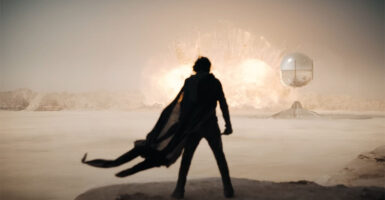NASA Beams The Mona Lisa Into Space By Laser, Possibly Synced To A Pink Floyd Album
This article is more than 2 years old

Remember that guy Leonardo Da Vinci, that old Italian hack that painted religious people and sorta came up with helicopters and all that? I mean, I’m sure he was a cool guy and all — he’s named after a Ninja Turtle, for one — but he used oil paint to produce his “classics.” I mean, how archaic can you get? That’s like saying I walked to my mailbox using a Homo Habilis’ feet. This is 2013. We use lasers for that shit. (Note: I was just joshing up there.)
The elusive smile of the Mona Lisa, arguably Da Vinci’s most famous work, has been beamed by laser to NASA’s Lunar Reconnaissance Orbiter (LRO), a spacecraft that has been going around the Moon since 2009, mapping things and waiting to assist in future lunar excursions. The Lunar Atmosphere and Dust Environment Explorer will be the source of that next excursion, and the successful laseriffic communication between land and space “sets the stage for the Lunar Laser Communications Demonstration, a high data rate laser-communication-demonstration that will be a central feature” of that mission, said researcher Richard Vondrak of the LRO.
If you thought fax machines were magic when they came out, this is even more amazing. The Goddard Space Flight Center in Greenbelt, MD, is where the Next Generation Satellite Laser Ranging station is located. From there, a series of laser signals were sent 240,000 miles to the LRO, which was optimal since it’s followed not only by radio signals but by laser as well. The Mona Lisa was mapped out into pixels and separated into sections that were 150 x 200 pixels each, and were then pulsed out via laser, using a timed system resembling Morse code that adjusted the image’s shading. Once that was complete, the image was sent back to earth using radio signals, and there she was, looking as pristine as something you would get from a fax machine. While that sounds slightly disparaging, it isn’t meant to. Lasers sent a message across that wasn’t, “Hey, look at me, I’m making myself laugh by pointing a laser where someone’s nipple would be if they weren’t wearing a shirt.”
“In the near future, this type of simple laser communication might serve as a backup for the radio communication that satellites use,” said David Smith, another researcher with LRO’s Lunar Orbiter Laser Altimeter. “In the more distance future, it may allow communication at higher data rates than present radio links can provide.”
If this means that, one day, radio stations will be shooting lasers into my brain filled with today’s modern hits and “another 50-minute commercial-free rockin’ rush hour,” then I hope to eat my Last Supper that day.












